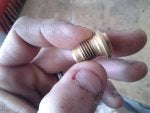I have been getting some very good ideas for time saving tips when it comes to service work since I've been hanging out here.
As an example, sealed- system work:
I picked up the idea here of using stubby gauges instead of pulling out the whole manifold.
What a time saver.
To some it might seem like a trivial gain but it was well worth the investment of putting together a few sets of gage heads and brass adapters to come up with a tool that SAVES .time and a few more dollars to my bottom line. Thanks to all the guys here a+ hvacr talk for all the handy tips and useful friendly information I have received.
As an example, sealed- system work:
I picked up the idea here of using stubby gauges instead of pulling out the whole manifold.
What a time saver.
To some it might seem like a trivial gain but it was well worth the investment of putting together a few sets of gage heads and brass adapters to come up with a tool that SAVES .time and a few more dollars to my bottom line. Thanks to all the guys here a+ hvacr talk for all the handy tips and useful friendly information I have received.






